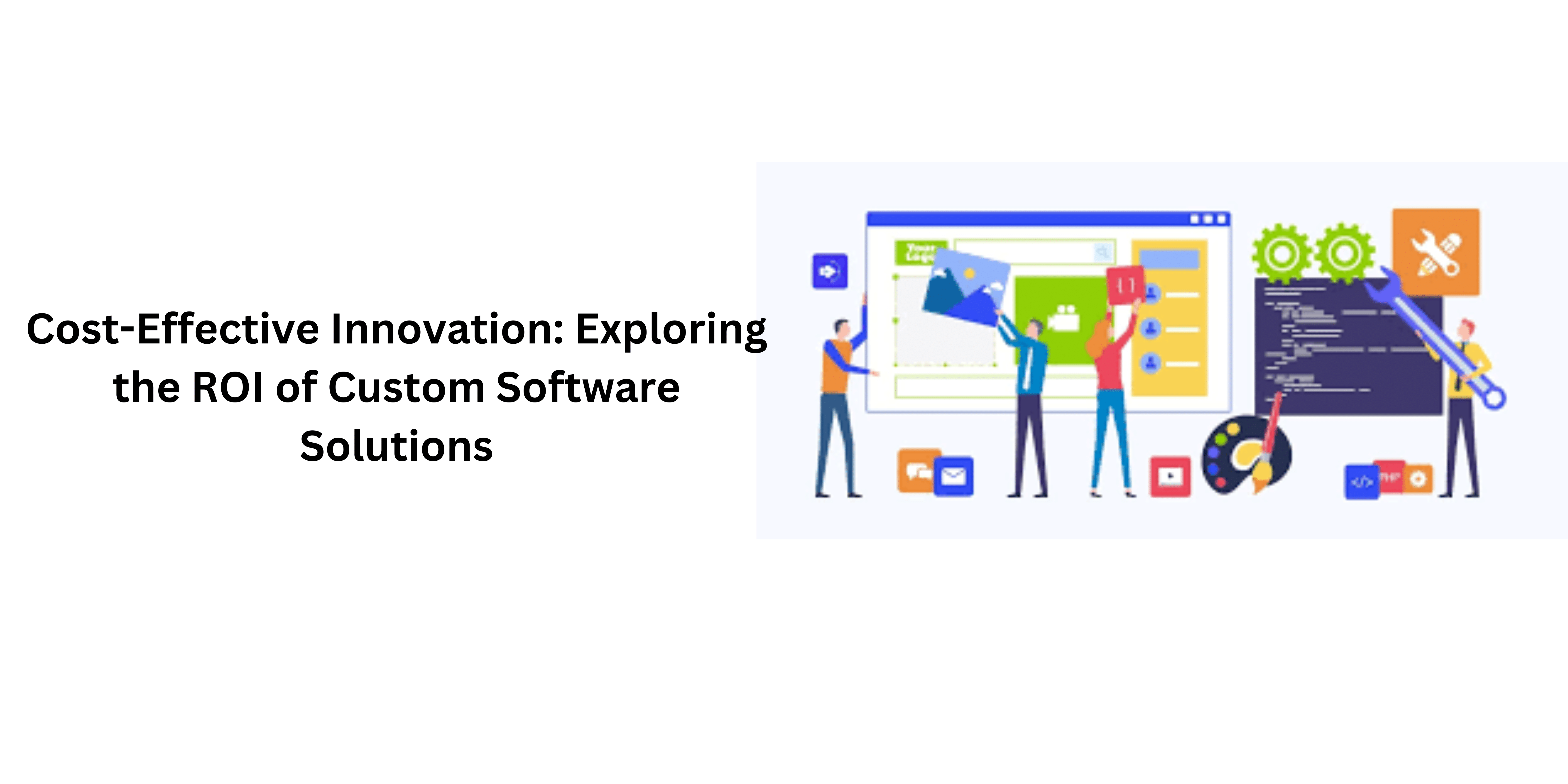In the dynamic landscape of technology-driven solutions, businesses are increasingly recognizing the pivotal role of custom software development in achieving cost-effective innovation. This paradigm shift stems from a comprehensive understanding of the Return on Investment (ROI) associated with tailored software solutions. As organizations navigate the complexities of the digital era, the pursuit of cost-effective solutions becomes imperative. This exploration aims to dissect the key components influencing the costs of custom software development, drawing comparisons with off-the-shelf alternatives.
By examining case studies and strategic planning methodologies, this discourse seeks to illuminate the nuanced dynamics of achieving tangible and intangible returns from bespoke software solutions. Through this lens, businesses can navigate the intricate landscape of innovation, optimizing resource allocation and ensuring sustainable, scalable, and user-centric solutions that contribute significantly to the bottom line.
Understanding Return on Investment (ROI) in Software Solutions
The concept of Return on Investment (ROI) is a critical lens through which businesses evaluate the financial success of their endeavors, and the realm of software solutions is no exception. Understanding ROI in the context of software development involves a multifaceted analysis that extends beyond immediate financial gains. ROI in this domain encompasses both tangible and intangible factors, including increased operational efficiency, enhanced customer satisfaction, and competitive advantage.
Tangible returns from software solutions can be quantified through metrics such as cost savings, revenue generation, and improved productivity. For example, custom software might streamline internal processes, reducing labor costs and minimizing errors, leading to direct financial benefits. Additionally, bespoke solutions can enable businesses to capitalize on new revenue streams by providing unique functionalities that distinguish them in the market.
On the other hand, intangible returns are often harder to measure but are equally valuable. These may include improved brand reputation, increased customer loyalty, and a more agile response to market changes. Custom software solutions can contribute to a positive brand image by demonstrating a commitment to innovation and tailored customer experiences. Moreover, the adaptability of custom solutions positions businesses to pivot swiftly in response to evolving market demands, providing a strategic advantage that is challenging to quantify but essential for long-term success.
In essence, a comprehensive understanding of ROI in custom software solutions necessitates a holistic assessment that considers both immediate financial gains and the broader, more subtle impacts on business operations and market positioning. This nuanced perspective enables organizations to make informed decisions about their investments in custom software development, aligning technological initiatives with overarching business goals for sustained success.
Key Factors Influencing Custom Software Development Costs
Custom software development costs are influenced by a myriad of factors that collectively shape the financial investment required for a successful project. Understanding these key factors is crucial for businesses aiming to navigate the complexities of budgeting and resource allocation in the realm of bespoke software solutions.
Project Scope and Complexity
The breadth and intricacy of the software project significantly impact costs. A comprehensive project scope that includes intricate functionalities will naturally require more resources and, consequently, higher costs.
Technical Requirements
The technical specifications and requirements of the software play a pivotal role. Integration with existing systems, compatibility across platforms, and adherence to industry standards can all contribute to the complexity and, subsequently, the cost of development.
Development Team Expertise
The skill set and experience of the development team directly correlate with costs. Highly skilled and experienced developers may command higher rates, but their proficiency often leads to more efficient and effective development processes.
Timeline and Urgency
The urgency of project completion can influence costs. Tight deadlines may require additional resources or overtime, impacting the overall budget.
Customization and Scalability Needs
The level of customization and scalability required will affect costs. Solutions tailored to specific business needs and designed for future growth often entail higher upfront investments.
Quality Assurance and Testing
Rigorous testing and quality assurance processes contribute to a robust and reliable software product. Budget considerations must include resources for comprehensive testing to ensure the software’s functionality, security, and performance.
Project Management and Communication
Efficient project management and clear communication contribute to smoother development processes. Investing in these aspects can mitigate potential delays and errors, impacting overall project costs positively.
By recognizing and accounting for these factors, businesses can undertake informed decision-making processes, fostering successful custom software development projects that align with budgetary constraints and strategic objectives.
Comparative Analysis: Off-the-Shelf vs. Custom Software
A comparative analysis between off-the-shelf (OTS) and custom software development is crucial for businesses seeking the most suitable technology to meet their unique needs. Each approach comes with distinct advantages and considerations, influencing the decision-making process based on factors such as functionality, cost, and scalability.
Off-the-shelf software refers to pre-packaged solutions readily available in the market. These solutions are designed to address common needs and are typically more affordable upfront. However, their generic nature may limit customization options, forcing businesses to adapt their processes to fit the software.
On the other hand, custom software is tailor-made to meet specific business requirements. This approach provides unparalleled flexibility and the ability to align the software closely with existing workflows. While custom solutions often involve higher upfront costs and longer development timelines, they offer a higher potential for long-term return on investment by precisely addressing unique organizational challenges.
In terms of functionality, off-the-shelf software provides a quicker implementation process but may lack certain features required for specialized business processes. Custom software, being bespoke, ensures that every feature is purpose-built, resulting in a solution that aligns seamlessly with the organization’s workflows.
Cost considerations extend beyond the initial investment. While off-the-shelf solutions are generally more affordable upfront, custom software can offer better long-term value by minimizing the need for additional tools and adaptations. The scalability of custom solutions is another key advantage, as they can evolve with the business, accommodating growth and changing requirements over time.
In conclusion, the choice between off-the-shelf and custom software hinges on the unique needs and priorities of the business. A thoughtful comparative analysis ensures that the chosen solution aligns not only with immediate requirements but also with the long-term strategic goals of the organization.
Strategic Planning for Cost-Efficient Custom Software Solutions
Strategic planning for cost-efficient custom software solutions is a pivotal process that involves careful consideration of various factors to ensure the successful development and implementation of bespoke technology aligned with organizational goals. This strategic approach not only optimizes resource utilization but also enhances the overall return on investment (ROI) in the long run.
Needs Assessment and Goal Definition
The initial phase involves a comprehensive assessment of organizational needs and the definition of specific goals. Understanding the unique requirements that the software must address forms the foundation for the strategic planning process.
Risk Analysis and Mitigation
Identifying potential risks and challenges in advance allows for proactive mitigation strategies. A thorough risk analysis helps in developing contingency plans, reducing the likelihood of cost overruns and project delays.
Scalability Planning
Strategic planning includes anticipating future growth and ensuring that the custom software solution is scalable. This proactive approach minimizes the need for extensive re-development as the organization evolves.
Agile Methodology Adoption
Incorporating Agile methodologies into the development process enhances flexibility and responsiveness. Agile allows for incremental development, enabling organizations to adapt to changing requirements and ensuring cost-efficient adjustments throughout the project.
Vendor Selection and Collaboration
Careful selection of development partners or vendors is crucial. Collaborating with experienced and reputable development teams ensures that the strategic goals are met efficiently, minimizing the risk of costly errors or suboptimal outcomes.
Continuous Communication and Feedback Loop
Establishing a robust communication framework and feedback loop facilitates ongoing collaboration between stakeholders and the development team. This iterative process ensures that the software aligns closely with evolving business needs, avoiding costly deviations from the original plan.
Technology Stack Optimization
Selecting an appropriate technology stack is vital for both performance and cost efficiency. The strategic choice of technologies that align with the project’s requirements helps in avoiding unnecessary expenses associated with over-engineering or technology redundancies.
In conclusion, strategic planning for cost-efficient custom software solutions involves a meticulous examination of organizational needs, proactive risk management, scalability considerations, agile methodologies, vendor collaboration, continuous communication, and technology optimization. This holistic approach positions businesses to derive maximum value from their custom software investments, fostering long-term success and adaptability in an ever-evolving technological landscape.
Measuring the Tangible and Intangible Returns from Software Innovation
Measuring the returns from software innovation involves a nuanced evaluation that spans both tangible and intangible dimensions, providing a comprehensive understanding of the impact on an organization. This dual perspective is crucial for businesses seeking to gauge the effectiveness of their software investments beyond mere financial metrics.
Tangible Returns:
- Cost Savings: Tangible returns often manifest in direct cost savings achieved through increased operational efficiency. Streamlined processes, reduced manual labor, and optimized resource allocation contribute to measurable financial benefits.
- Revenue Generation: Tangible returns can also be quantified through increased revenue streams facilitated by innovative custom software solution development. Whether through enhanced customer experiences, new market opportunities, or improved product/service delivery, revenue metrics directly reflect the software’s impact on the organization’s bottom line.
- Efficiency Metrics: Metrics such as improved processing times, reduced errors, and increased productivity are tangible indicators of software innovation’s effectiveness. These metrics offer quantifiable evidence of the software’s operational impact.
Intangible Returns:
- Enhanced Customer Satisfaction: Software innovation often results in improved user experiences and customer satisfaction. While challenging to quantify precisely, positive feedback, increased customer loyalty, and brand advocacy are intangible returns that contribute significantly to organizational success.
- Adaptability and Agility: The ability to adapt swiftly to market changes or internal dynamics is an intangible yet valuable return from software innovation. An agile software environment enables organizations to pivot quickly in response to evolving business needs, contributing to long-term competitiveness.
- Innovation Culture: Fostering an innovation culture within the organization is an intangible return that pays dividends over time. Software innovation sets a precedent for creative problem-solving, encouraging employees to think critically and contribute to continuous improvement.
Comprehensive Evaluation:
Combining both tangible and intangible metrics provides a holistic picture of the software’s impact. While financial metrics offer a direct assessment, intangible returns capture the broader, often strategic, benefits that contribute to the organization’s overall resilience and competitiveness in a dynamic business landscape. By considering both dimensions, businesses can effectively measure the true success of their software innovation initiatives.
Optimizing Resource Allocation for Maximum ROI
Optimizing resource allocation for maximum Return on Investment (ROI) is a strategic imperative for businesses aiming to achieve efficiency and profitability in their projects. Efficient use of resources ensures that every investment, whether financial, human, or technological, contributes to the overall success of the endeavor.
Strategic Planning
The foundation of resource optimization lies in strategic planning. Clearly defined project goals, a comprehensive understanding of requirements, and a roadmap for execution enable businesses to allocate resources judiciously.
Skillful Workforce Deployment
Matching the right skills to specific tasks is crucial for resource optimization. Identifying the strengths of team members and aligning them with project requirements not only enhances productivity but also minimizes the risk of errors and rework.
Technological Infrastructure Investment
Investing in the right technological infrastructure is essential for optimizing resources. Choosing tools and technologies that align with the project’s needs improves efficiency, streamlines processes, and reduces the likelihood of resource wastage.
Risk Management
Anticipating and mitigating risks is integral to resource optimization. By identifying potential challenges early in the project, businesses can allocate resources for contingency planning, minimizing the impact of unforeseen issues on timelines and budgets.
Agile Methodologies
Adopting Agile methodologies facilitates iterative development and constant feedback loops, allowing for real-time adjustments to resource allocation. This dynamic approach ensures that resources are directed toward the most valuable and impactful tasks throughout the project lifecycle.
Monitoring and Evaluation
Regular monitoring and evaluation of project progress are essential for resource optimization. Key performance indicators (KPIs) and benchmarks help businesses assess the effectiveness of resource allocation, enabling adjustments for maximum ROI.
Scalability Considerations
Planning for scalability is critical, particularly in the dynamic business landscape. Resource optimization involves considering future growth and ensuring that the allocated resources can scale alongside the evolving needs of the project or organization.
In conclusion, optimizing resource allocation for maximum ROI demands a strategic and dynamic approach. By aligning skills, technology, and contingency planning with project goals, businesses can ensure that their resources contribute to the overall success of initiatives, resulting in enhanced efficiency, profitability, and long-term value.
Risk Mitigation in Custom Software Development: A Financial Perspective
Risk mitigation in custom software development, viewed through a financial lens, is a critical aspect that ensures projects stay within budgetary constraints and deliver value to the organization. Addressing potential risks proactively helps in avoiding costly setbacks, overruns, and financial implications that may arise during the development lifecycle.
Thorough Risk Analysis
A financial perspective on risk mitigation starts with a comprehensive analysis of potential risks. This includes identifying technical, operational, and external factors that could impact the project’s timeline and budget. By understanding these risks upfront, organizations can develop strategies to mitigate their financial impact.
Contingency Budgeting
Incorporating contingency budgets is a key financial strategy in risk mitigation. Allocating a portion of the budget specifically for addressing unforeseen challenges provides a financial safety net. This ensures that unexpected issues can be addressed without compromising the overall financial health of the project.
Agile Methodologies
From a financial standpoint, adopting Agile methodologies is a proactive approach to risk mitigation. Agile allows for iterative development, continuous feedback, and the flexibility to adapt to changing requirements. This minimizes the financial impact of changes or unexpected challenges by addressing them in smaller, more manageable increments.
Insurance and Legal Safeguards
Implementing insurance and legal safeguards is another financial aspect of risk mitigation. This may include obtaining professional liability insurance to cover potential losses due to software defects or legal agreements that clearly define responsibilities and liabilities, protecting the organization from financial ramifications.
Regular Monitoring and Reporting
Financial risk mitigation in custom software development involves continuous monitoring and reporting. Regular financial assessments, coupled with progress reports, allow organizations to identify potential issues early on, enabling timely adjustments to mitigate the impact on the budget.
Vendor Evaluation and Due Diligence
For organizations outsourcing custom software development, due diligence in vendor selection is paramount. A financial perspective includes assessing the financial stability of the chosen vendor to ensure they have the resources to complete the project without financial strain or potential disruptions.
In conclusion, a financial perspective on risk mitigation in custom software development involves a proactive approach to identifying, assessing, and addressing potential risks. By integrating contingency planning, Agile methodologies, insurance, and diligent vendor selection, organizations can safeguard their financial investments and enhance the likelihood of successful project outcomes.
Evaluating Long-Term Cost Savings through Custom Solutions
Evaluating long-term cost savings through custom solutions involves a comprehensive analysis of the financial benefits derived from tailored software over an extended period. Custom solutions, while often requiring a higher initial investment, can yield substantial returns and cost efficiencies over time.
Upfront Investment vs. Long-Term Value
While the upfront costs of developing custom solutions may seem higher compared to off-the-shelf alternatives, the long-term value is a critical consideration. Custom solutions are specifically designed to meet the unique needs of an organization, offering tailored features and functionalities that contribute directly to operational efficiency.
Reduced Operational Costs
One of the primary sources of long-term cost savings with custom solutions lies in reduced operational costs. Streamlining business processes, automating repetitive tasks, and optimizing workflows contribute to ongoing operational efficiency. Over time, these efficiencies translate into savings through reduced labor costs, increased productivity, and minimized errors.
Scalability and Adaptability
Custom solutions are designed with scalability in mind, allowing organizations to adapt to growth and evolving requirements without the need for extensive modifications or replacements. This adaptability results in long-term cost savings by avoiding the frequent need for new software investments as the business expands.
Minimized Integration Costs
Custom solutions can integrate seamlessly with existing systems, minimizing the costs associated with retrofitting or replacing incompatible off-the-shelf software. This integration capability reduces disruption and additional expenses related to system overhauls.
Extended Lifecycle and Support
Custom solutions often have longer lifecycles compared to off-the-shelf alternatives, as they are specifically tailored to an organization’s needs. This longevity contributes to cost savings by reducing the frequency of software upgrades, migrations, and the associated learning curve for users.
Competitive Advantage and Revenue Generation
Custom solutions can provide a competitive advantage, contributing to increased market share and revenue generation. The ability to offer unique features or services can attract and retain customers, resulting in sustained financial benefits over the long term.
In conclusion, evaluating long-term cost savings through custom solutions involves a holistic understanding of the ongoing operational efficiencies, scalability, adaptability, integration capabilities, extended lifecycle, and competitive advantages that bespoke software brings to an organization. While the initial investment may be higher, the enduring value and cumulative savings position custom solutions as a strategic and financially prudent choice for businesses.
Agile Methodology: A Cost-Efficient Approach to Software Development
Agile methodology has emerged as a cornerstone in cost-efficient software development, revolutionizing traditional approaches with its iterative, flexible, and collaborative framework. This methodology, rooted in adaptive planning and continuous improvement, offers several advantages that contribute to cost efficiency throughout the software development lifecycle.
Iterative Development and Continuous Feedback
Agile promotes iterative development cycles, allowing for the incremental delivery of features. This iterative approach enables stakeholders to provide continuous feedback, facilitating early identification and resolution of issues. By addressing feedback promptly, Agile minimizes the risk of costly errors and ensures that the final product aligns closely with user expectations.
Adaptability to Changing Requirements
In the dynamic landscape of software development, requirements often evolve. Agile’s flexibility allows teams to adapt to changing needs without significant disruptions. This adaptability reduces the likelihood of expensive scope changes or late-stage modifications, resulting in cost savings over the course of the project.
Enhanced Collaboration and Communication
Agile places a strong emphasis on collaboration and open communication among cross-functional teams. This collaborative environment fosters a shared understanding of project goals, reduces misunderstandings, and accelerates decision-making processes. Improved communication contributes to efficiency gains and helps prevent costly rework due to misalignment.
Risk Mitigation and Transparency
Agile’s emphasis on regular assessments and continuous monitoring enables proactive risk management. Potential issues are identified early in the development process, allowing teams to implement timely solutions and mitigate risks that could otherwise lead to budget overruns or project delays. The transparency inherent in Agile practices ensures that stakeholders are well-informed, fostering trust and reducing the likelihood of unexpected financial setbacks.
Customer Satisfaction and Value Delivery
By delivering incremental value throughout the development process, Agile ensures that customer needs are met continuously. This focus on customer satisfaction not only enhances the quality of the final product but also reduces the likelihood of costly rework or dissatisfaction after the project’s completion.
In summary, Agile methodology’s emphasis on iterative development, adaptability, collaboration, risk mitigation, and customer satisfaction make it a cost-efficient approach to software development. Its principles and practices align with the dynamic nature of the industry, allowing organizations to maximize efficiency and deliver high-quality, value-driven solutions within budgetary constraints.
Ensuring Scalability and Adaptability for Sustainable Cost Savings
Ensuring scalability and adaptability in software development is essential for achieving sustainable cost savings over the long term. Scalability refers to a system’s ability to handle growing amounts of work, users, or data, while adaptability involves the capacity to adjust to changing requirements and technological landscapes. Together, they contribute to the resilience and efficiency of software solutions, minimizing the need for frequent and costly modifications.
Future-Proofing Investments
Developing custom software with scalability and adaptability in mind is a strategic investment in the future. As organizations grow, experience changes in user demands, or face technological advancements, scalable and adaptable solutions can evolve seamlessly, reducing the necessity for extensive redevelopment or replacements.
Cost Savings through Incremental Growth
Scalable solutions allow organizations to grow incrementally, adding new features or accommodating increased user loads without major overhauls. This incremental approach to expansion facilitates sustainable cost savings, as resources can be allocated more efficiently over time without large upfront investments.
Flexibility in Technology Adoption
Technological landscapes evolve rapidly, and software designed with adaptability can easily integrate new technologies. This flexibility reduces the risk of obsolescence and allows organizations to take advantage of emerging tools and platforms without undergoing costly redevelopments.
Minimized Disruptions and Downtime
Scalable and adaptable systems can accommodate changes without causing disruptions or downtime. This reduces the financial impact of system modifications, ensuring continuous operation and minimizing the potential for revenue loss associated with service interruptions.
User-Centric Adjustments
Adaptability extends to meeting evolving user needs. Software that can be easily adjusted based on user feedback or changing market demands ensures sustained user satisfaction. By avoiding the costs associated with extensive user training or dissatisfaction, organizations can achieve long-term cost savings.
Agile Development Practices
Adopting Agile methodologies supports scalability and adaptability by emphasizing iterative development, continuous feedback, and the ability to respond to changing requirements. This agile approach contributes to sustainable cost savings by reducing the likelihood of costly rework and ensuring that the software aligns closely with organizational goals and user expectations.
In conclusion, ensuring scalability and adaptability in software development is a prudent financial strategy. By future-proofing investments, enabling incremental growth, embracing technological flexibility, minimizing disruptions, and incorporating user-centric adjustments, organizations can achieve sustainable cost savings and maintain the relevance and efficiency of their software solutions over time.
User-Centric Design: Impact on Development Costs and ROI
User-centric design, often considered a cornerstone of successful software development, has a profound impact on both development costs and Return on Investment (ROI). This design approach prioritizes the needs and experiences of end-users throughout the development process, influencing various aspects that contribute to the overall financial success of a project.
Reduced Iterations and Rework
User-centric design involves gathering user feedback early and consistently. By incorporating user input from the beginning, the likelihood of major design overhauls or rework decreases. This not only saves development time but also reduces associated costs, contributing to overall project efficiency.
Enhanced User Satisfaction
A software product that aligns closely with user expectations tends to result in higher user satisfaction. Satisfied users are more likely to engage with the product consistently, reducing the risk of costly user churn and negative word-of-mouth, both of which can impact the long-term ROI of a software solution.
Minimized Support and Training Costs
A user-friendly design can significantly reduce the need for extensive customer support and training. Intuitive interfaces and streamlined user experiences contribute to a lower learning curve, minimizing the resources required for user onboarding and ongoing support, and ultimately reducing associated costs.
Increased Adoption and Market Success
User-centric design contributes to the market success of a software product. By meeting user needs and expectations, a well-designed product is more likely to gain user adoption. This increased market share and positive user reception directly impact the ROI by expanding the user base and potentially opening avenues for upselling or additional revenue streams.
Agile Adaptation to User Feedback
Adopting user-centric design principles aligns well with Agile development methodologies. Agile emphasizes continuous user feedback and iterative development, allowing for quick adaptations based on user input. This iterative approach ensures that development efforts are focused on features that add value to users, positively influencing both development costs and ROI.
In conclusion, user-centric design is a strategic investment in the financial success of a software project. By minimizing iterations, enhancing user satisfaction, reducing support and training costs, increasing market adoption, and aligning with Agile methodologies, organizations can optimize both development costs and long-term ROI, creating software solutions that resonate with and serve the needs of their users effectively.
Security Considerations in Custom Software Solutions: Balancing Cost and Protection
Addressing security considerations in custom software solutions involves a delicate balance between cost-effectiveness and robust protection. While prioritizing security incurs additional expenses, the potential costs associated with data breaches or vulnerabilities can far outweigh the initial investment. Striking the right balance is crucial for organizations seeking to safeguard sensitive information and maintain the trust of their users.
Thorough Risk Assessment
A comprehensive risk assessment is the foundation for balancing security and cost. Identifying potential threats, vulnerabilities, and the potential impact of security breaches allows organizations to allocate resources judiciously, focusing on the most critical areas without unnecessary expenditures.
Adopting Industry Best Practices
Following established security best practices is a cost-effective approach to minimizing risks. Utilizing encryption, implementing secure coding standards, and adhering to recognized security frameworks can enhance protection without exorbitant expenses.
Continuous Monitoring and Incident Response
Proactive security measures, such as continuous monitoring and incident response planning, contribute to cost-effective security. Identifying and addressing security issues in real-time minimizes the financial impact of breaches, reducing potential legal and reputational costs.
Customized Security Solutions
Tailoring security measures to the specific needs and risks of the organization ensures a cost-effective approach. Customized security solutions allow organizations to focus resources on the most relevant threats, avoiding unnecessary expenses on generic or overblown security measures.
Employee Training and Awareness
Human error is a common cause of security breaches. Investing in employee training and awareness programs is a cost-effective strategy to bolster security. Educated employees are more likely to follow security protocols, reducing the risk of inadvertent breaches.
Regulatory Compliance
Complying with industry regulations and standards is not only a legal requirement but also a cost-effective security strategy. Aligning with established frameworks ensures that security measures meet recognized standards, preventing potential legal consequences and financial penalties.
In conclusion, balancing cost and protection in custom software solutions requires a nuanced approach. A thorough risk assessment, adherence to industry best practices, continuous monitoring, customized security solutions, employee training, and compliance with regulations collectively contribute to a cost-effective security strategy. The upfront investment in security measures is a prudent safeguard against potential financial and reputational losses associated with security breaches in the long run.
Emerging Technologies and Their Potential Cost-Effective Impact on Innovation
Exploring emerging technologies and their potential cost-effective impact on innovation is crucial for organizations aiming to stay competitive and foster continuous improvement. Several cutting-edge technologies offer not only transformative capabilities but also opportunities for cost efficiency across various industries.
Artificial Intelligence (AI) and Machine Learning (ML): AI and ML technologies enable automation, data analysis, and predictive capabilities. Implementing AI-driven solutions can streamline processes, reduce manual intervention, and enhance decision-making, leading to cost efficiencies in operations, resource allocation, and improved overall productivity.
Internet of Things (IoT): IoT connects devices and enables data exchange, fostering real-time monitoring and control. This connectivity can lead to optimized resource usage, predictive maintenance, and improved efficiency in various sectors, resulting in long-term cost savings.
Blockchain Technology: Blockchain ensures secure and transparent data sharing, reducing the need for intermediaries and enhancing trust. In industries such as finance and supply chain, implementing blockchain can streamline processes, reduce fraud, and minimize transaction costs.
Edge Computing: Edge computing brings computational capabilities closer to the data source, reducing latency and improving processing efficiency. This technology is particularly advantageous for applications requiring real-time processing, offering cost-effective solutions for data-intensive tasks.
Robotic Process Automation (RPA)
RPA automates repetitive tasks, enhancing operational efficiency and reducing the need for human intervention in mundane processes. This technology contributes to cost savings by freeing up human resources for more complex and value-added activities.
Augmented Reality (AR) and Virtual Reality (VR)
AR and VR technologies find applications in training, design, and simulations, reducing the need for physical prototypes or extensive training facilities. This cost-effective approach enhances learning experiences, design iterations, and collaborative efforts.
5G Technology
The advent of 5G technology brings faster and more reliable connectivity. This enables quicker data transfer, enhances communication, and supports the implementation of IoT and other technologies, contributing to overall operational efficiency and cost-effectiveness.
By strategically adopting and integrating these emerging technologies into their operations, organizations can unlock new possibilities for innovation and cost savings. However, it is essential to carefully assess the specific needs and challenges of each organization to tailor the adoption of these technologies for maximum impact and efficiency.
The Key Takeaway
In conclusion, the exploration of cost-effective innovation through custom software solutions and emerging technologies underscores the dynamic landscape organizations navigate to stay competitive and adaptive. Strategic planning, user-centric design, and the judicious allocation of resources contribute to the success of custom software development, ensuring long-term value and return on investment.
Balancing security considerations in this technological landscape is paramount, as organizations must protect sensitive information while managing costs. Additionally, leveraging emerging technologies like AI, IoT, blockchain, and others holds immense potential for driving innovation and operational efficiency. As businesses continue to embrace these advancements, a keen focus on scalability, adaptability, and the evolving needs of end-users becomes crucial for sustained success.
The careful integration of these elements not only fosters innovation but also positions organizations to navigate the complexities of the digital era, achieving a harmonious balance between cost-effectiveness and technological advancement.











